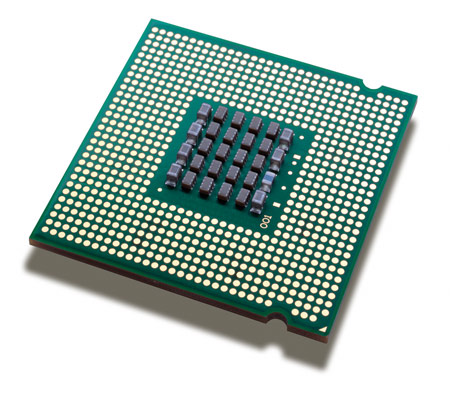HP Chip Breakthrough: CPUs Could Store And Process Data
Currently, transistors can be produced as small as 22nm. Most are
produced at 45nm or larger. But even the most optimistic engineers
admit that this squishing process that has enabled the CPU world to
follow Moore's Law (double in power every 2 years) won't work forever.
Eventually, a new type of processor building must occur if we expect
our chips to continue to get faster, and HP is working hard to
discover that new route before we hit a wall using the current
technique.
According to new research published by the company, new memristors could be that missing link. These tiny devices were actually thought and proposed around 40 years ago, but they just started fabrication in 2008. Now, HP has found that they can be used to not only crunch data like a typical CPU, but store information like RAM. Basically, CPUs build with these new memristors could be much more efficient than using the CPU + memory tandem that we rely on today.

HP says this discovery represents the fourth basic circuit element in electrical engineering, and it can perform logic, enabling computation to one day be performed in chips where data is stored, rather than on a specialized central processing unit. There's still no definite time frame for which HP intends to ship these, and by our estimation, there's still a lot of traditional CPUs to be built before we hop on an entirely different bandwagon. But just look at the GPU market. Ten years ago, the GPU only handled a very small amount of tasks, and today, these cards handle very advanced computations on their own with no real help from the CPU. Could RAM one day become unimportant as it's integrated into the CPU? We, and our benchmarks, are eager to find out.

According to new research published by the company, new memristors could be that missing link. These tiny devices were actually thought and proposed around 40 years ago, but they just started fabrication in 2008. Now, HP has found that they can be used to not only crunch data like a typical CPU, but store information like RAM. Basically, CPUs build with these new memristors could be much more efficient than using the CPU + memory tandem that we rely on today.

HP says this discovery represents the fourth basic circuit element in electrical engineering, and it can perform logic, enabling computation to one day be performed in chips where data is stored, rather than on a specialized central processing unit. There's still no definite time frame for which HP intends to ship these, and by our estimation, there's still a lot of traditional CPUs to be built before we hop on an entirely different bandwagon. But just look at the GPU market. Ten years ago, the GPU only handled a very small amount of tasks, and today, these cards handle very advanced computations on their own with no real help from the CPU. Could RAM one day become unimportant as it's integrated into the CPU? We, and our benchmarks, are eager to find out.

Highlights
- The latest findings about the memristor are detailed in a paper published this week in the journal “Nature” by six researchers at HP’s Information and Quantum Systems Lab, led by R. Stanley Williams. These developments follow the HP Labs team’s first demonstration of the existence of the memristor in 2008.
- HP has created development-ready architectures for memory chips using memristors and believes it is possible that devices incorporating the element could come to market within the next few years.
- HP researchers also have designed a new architecture within which multiple layers of memristor memory can be stacked on top of each other in a single chip. In five years, such chips could be used to create handheld devices that offer ten times greater embedded memory than exists today or to power supercomputers that allow work like movie rendering and genomic research to be done dramatically faster than Moore’s Law suggests is possible.
- Eventually, memristor-based processors might replace the silicon in the smart display screens found in e-readers and could one day even become the successors to silicon on a larger scale.
Memristor chips and energy use
- Memristors require less energy to operate and are faster than present solid-state storage technologies such as flash memory, and they can store at least twice as much data in the same area.
- Memristors are virtually immune from radiation, which can disrupt transistor-based technologies – making them an attractive way to enable ever smaller but ever more powerful devices.
- Because they do not “forget,” memristors can enable computers that turn on and off like a light switch.

